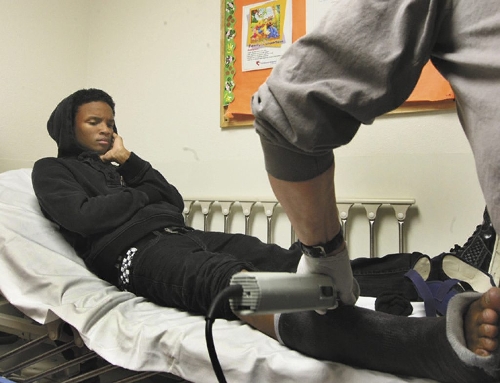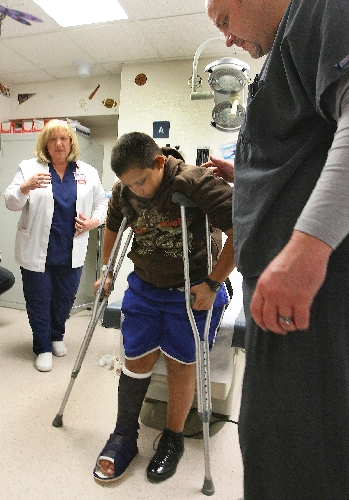UMC clinic helps patch youngsters
A playground fall left 9-year-old Ismael More with a broken lower right leg. A new jump 14-year-old Kyle DeBray tried on his skateboard resulted in a badly torn left ankle ligament.
Too much hustle on the stairs at home caused 14-year-old Cierra Koch-Azeke to miss a step and fracture bones in her left foot. An awkward landing after soaring through the air in a game of hoops chipped a bone in 16-year-old Fredrick Wright II's right foot.
On a recent Monday, the youngsters, plus about 30 others in need of treatment, came to the Children's Hospital of Nevada Pediatric Orthopedic Clinic at University Medical Center.
They definitely weren't the first. And unless taxpayer funded UMC goes under because of financial woes, they won't be the last.
"We've had this clinic on Monday mornings for about 20 years for kids from families without much income," said Nancy Harpin, manager of the pediatric emergency department. "We average about 20 to 40 kids each clinic. And I wouldn't be surprised if the demand becomes greater because of this terrible economy. This is really part of our mission, helping children whose families don't have a lot of means."
Though for most youngsters the clinic -- which begins at 7 a.m. -- is their second medical stop after suffering an injury, it is the most important.
"They'll go to an emergency room first, and they'll get a splint or a half cast," Harpin said. "The swelling has to go down. And then they come here and we can put a cast on so their injury heals right."
What would often cost families without insurance $500 to $800 at a private orthopedic surgeon, with $200 upfront, runs $75 at the clinic Harpin said.
"UMC is a godsend right now," Fredrick Wright said as he watched them cut the cast off his son, who had been treated at the clinic weeks before.
A disabled veteran from the Gulf War, Wright, who also has a teenage daughter, said he has been unemployed for months despite having a college degree in business.
"I don't know what I would have done for my son without UMC," he said.
Harpin said the clinic, which almost breaks even financially, contains costs by operating out of the emergency room area. For example, the X-ray technician and nurse are emergency room employees.
"At 7 in the morning on a Monday, the pediatric emergency room is slow," Harpin said. "So we don't have to bring in any more employees or do overtime. The techs who do casting are already on staff. There's no additional facility cost, and we have sedation, if we need it, right there. It's very efficient."
About half the patients, who must be under 17, who show up at the clinic overseen by Dr. Anthony Serfustini have no insurance. The other half have Medicaid, a program funded by the federal and state governments, which pays for medical care for those who can't afford it.
Those who may show up at the clinic with private insurance are referred to the orthopedic surgeons under their health plans.
"We couldn't provide this service to large numbers with the staff we have for it," she said.
Harpin said she becomes emotional when she sees families without financial resources, who haven't known about the clinic, finally walk in with a child that has an arm that is well on the way to becoming permanently deformed.
"I'm so glad they finally find us, or that child could be hurt for life, unable to play or perhaps even work," she said.
Sam Azeke, whose daughter Cierra fell down the stairs, said UMC has helped his family and many others by allowing payments for the initial emergency room visit. That first visit can cost between $600 and $2,000, depending on how much medical treatment must be done.
A self-employed businessman who said the economy has kept him from affording insurance for his family, Azeke said UMC, which loses about $10 million a year, receives "too much undeserved criticism."
"Without UMC so many people wouldn't be able to get medical treatment for their kids. Who would care for them?"
There's no question that for many children injuries become an unwelcome rite of passage.
Consider these 2009 national statistics for patients up to 18 years old from the Consumer Product Safety Commission that the American Academy of Orthopaedic Surgeons disseminates to membership. They include all medically treated nonfatal consumer product injuries, including emergency room, clinic and doctor visits as well as hospital admission.
Injuries resulted from:
■ Football 1,200,146
■ Basketball 810,141
■ Bicycles 700,746
■ Baseball 279,151
■ Skateboards 254,733
■ Mountain and all terrain bikes 3,405
Also in 2009, there were more than 490,000 injuries related to playground equipment that were treated in doctors' offices, emergency rooms and clinics.
"It is important to us at UMC that children without financial means get their injuries treated correctly," said Serfustini, who generally has one or two residents working with him.
The injuries treated at the Monday clinics include sprains and strains and fractures that are not too complex, he said.
He also said that families which show up with a child with a congenital deformity such as a club foot will be referred to the Shriner's Hospitals, which perform free orthopedic care for children under 18.
While the nearest Shriner's Hospital is in California, clinics are frequently held in Las Vegas, so that doctors can determine if medical care is warranted.
On this day at the clinic, orthopedic technician Tim Boyd fits Cierra Koch-Azeke with a cast that he said she should be able to walk in.
"Will I be able to dance?" she asked, smiling.
"I don't know why not," Boyd replied.
Contact reporter Paul Harasim at pharasim@reviewjournal.com or 702-387-2908.























